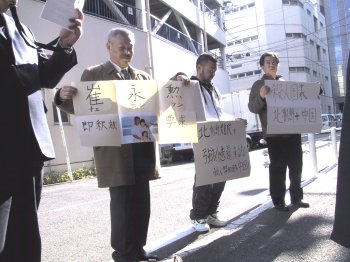Protests Held at Chinese Embassy & Consulate in Japan
Journalists Swell the Crowd in Tokyo Demonstration
Actual participants numbered perhaps 30 or so, but with the journalists buzzing around our group, the crowd probably looked larger to the double-handful of guards blocking the gate to the Chinese embassy in Tokyo. We were careful to maintain order and obey the laws, but it appeared the embassy staff didn’t want to take chances. The guards remained serious and watchful throughout the protest.
As part of our message, we read out the names of 160 North Korean defectors who have allegedly been repatriated by China.
As the protest ended, the representatives of our three groups walked to the embassy mailbox and attempted to insert letters detailing our requests.
The guards immediately stopped them, explaining that the Chinese embassy refuses all protest letters.
But I decided to knock on the reception window and, using the Chinese I had learned during my 8 months in Chinese prison, I spoke with the receptionist behind the window, who refused it also.
Unwilling to give up, I slid the letter through a narrow slit in the receptionist’s window. The receptionist immediately closed the shutter so that no further documents could be inserted.
Smaller Protest at China’s Consulate in Osaka
 Placard 1 requests the immediate release of Choi Yong-hun, the South Korean humanitarian aid worker now serving a 5-year term for his part in the Yantai boatpeople incident. (In this incident in 2002, more than 60 NK refugees were arrested as they attempted to leave China by boat. More than half of them have already been repatriated.)
Placard 1 requests the immediate release of Choi Yong-hun, the South Korean humanitarian aid worker now serving a 5-year term for his part in the Yantai boatpeople incident. (In this incident in 2002, more than 60 NK refugees were arrested as they attempted to leave China by boat. More than half of them have already been repatriated.)
Placard 2 demands an immediate halt to repatriation of NK refugees.
Placard 3 says, “North Korea and China – Two nations united in murder.”





